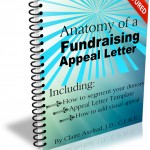In a recent Clairification post I told you I collect fundraising appeals. I suggested you do so as well. When you’ve got a nice little bunch, get together with your team and evaluate them. Figure out together what makes them work.
There are some neat little tricks I’ve learned over my 30+ year career that can really give your appeal a leg up. In the previous post we looked at the power of the word “because.” Today we’re going to look at the power of another simple word.
That word is YOU.
Did you know that “you” is one of the five most powerful words in the English language?
Does your appeal use YOU?
You can prevent the unhappy ending. Yes, “you!” Your letter should be written to compel your reader; not to talk about how great your organization is. “We,” “I” and “Our” have no place in your fundraising appeal.
Why? This is personal. Your donor is the hero. Your job is to let your donor know she can do something, personally, about the problem.
You can send a kid to college.
You can prevent a child from sleeping on the streets.
Never forget your job: to invite people to join you in something amazing… essential… critical… inspiring. It’s about the experience. The outcome. The impact. And who makes that possible? Your donor!
And when you’re writing to your donor, what does this mean?
“YOU.”
“You fed children last year.” Not “we fed children last year.”
“You stepped up.” Not “Our nonprofit stepped up.”
Don’t make your appeals about you. Make it about your donor’s experience. Use “you” rather than “I” or “we” or “our.” Cross out all the ego-centric stuff and rewrite. As veteran communicator Tom Ahern says:
“You” is glue. Every time you use it (especially in headlines) the reader pays slightly more attention…involuntarily. Readers can’t help it! They’re hard-wired to respond to “you”! It’s the best cheap trick I know.”
People listen for the word YOU in a sentence to see when the conversation will come back around to them.
Guess what else people listen for?
Their own name.
The point of using “you” or “Claire” (assuming that’s your reader’s name) is that it’s reader-centric. In fact, few things light people up as much as seeing their own name in print.
Call your donor by name (no “Dear Friend”) and show them how they – not you/your organization — can save the day.
Do this not only with the salutation in your letter, but also in the subject line of your email appeal. And think about other ways you might personalize your appeal, such as using something particularly descriptive of your reader such as geographic location (“Special for all Peninsula donors”), relationship with your organization (“Dear awesome monthly giving club donor”) or age/status (“Especially for Moms”).
Simply by using these connecting words you make your appeal relevant to the reader. The more relevant, the more likely your prospect will remain engaged. The more engaged, the more likely your prospect will take the next step. Voila! You’ve got your gift.
It’s December 1st. You’ve still got time to review your follow-up letters, email appeals and website copy. Stuff in the good “you” word wherever you can.
Year-End Fundraising “Cheat Sheets”
Get some quick tips using my Year-End Fundraising To-Do’s and Checklists e-Book to review a few things that can mean a big difference in your results. For a simple, step-by-step guide to crafting a killer appeal letter get my Anatomy of a Fundraising Appeal + Sample Template. I promise you’ll more than make up the $17 bucks you spend on either Guide — or I’ll make a donation to your nonprofit to assure that you do! Grab the To-Do’s and Checklists here and the Appeal Template here. Tell me what happens!
Photo courtesy of Freedigitalphotos.net








We will definitly test this tips!
Thanks Claire 🙂
Very many good points. Thank you